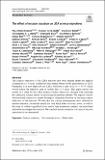The effect of mission duration on LISA science objectives
Author(s)
Amaro Seoane, Pau; Arca Sedda, Manuel; Babak, Stanislav; Berry, Christopher P. L.; Berti, Emanuele; Bertone, Gianfranco; Blas, Diego; Bogdanović, Tamara; Bonetti, Matteo; Breivik, Katelyn; Brito, Richard; Caldwell, Robert; Capelo, Pedro R.; Caprini, Chiara; Cardoso, Vitor; Carson, Zack; Chen, Hsin-Yu; ... Show more Show less
Download10714_2021_Article_2889.pdf (2.374Mb)
Publisher with Creative Commons License
Publisher with Creative Commons License
Creative Commons Attribution
Terms of use
Metadata
Show full item recordAbstract
Abstract
The science objectives of the LISA mission have been defined under the implicit assumption of a 4-years continuous data stream. Based on the performance of LISA Pathfinder, it is now expected that LISA will have a duty cycle of
$$\approx 0.75$$
≈
0.75
, which would reduce the effective span of usable data to 3 years. This paper reports the results of a study by the LISA Science Group, which was charged with assessing the additional science return of increasing the mission lifetime. We explore various observational scenarios to assess the impact of mission duration on the main science objectives of the mission. We find that the science investigations most affected by mission duration concern the search for seed black holes at cosmic dawn, as well as the study of stellar-origin black holes and of their formation channels via multi-band and multi-messenger observations. We conclude that an extension to 6 years of mission operations is recommended.
Date issued
2021-12-27Department
LIGO (Observatory : Massachusetts Institute of Technology)Publisher
Springer US
Citation
General Relativity and Gravitation. 2021 Dec 27;54(1):3
Version: Final published version